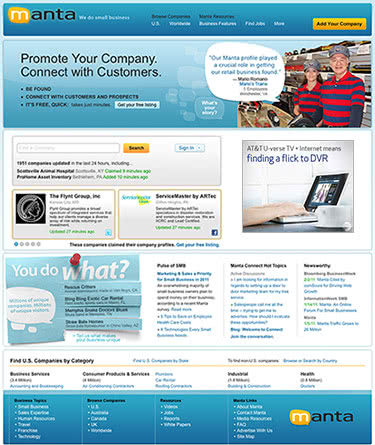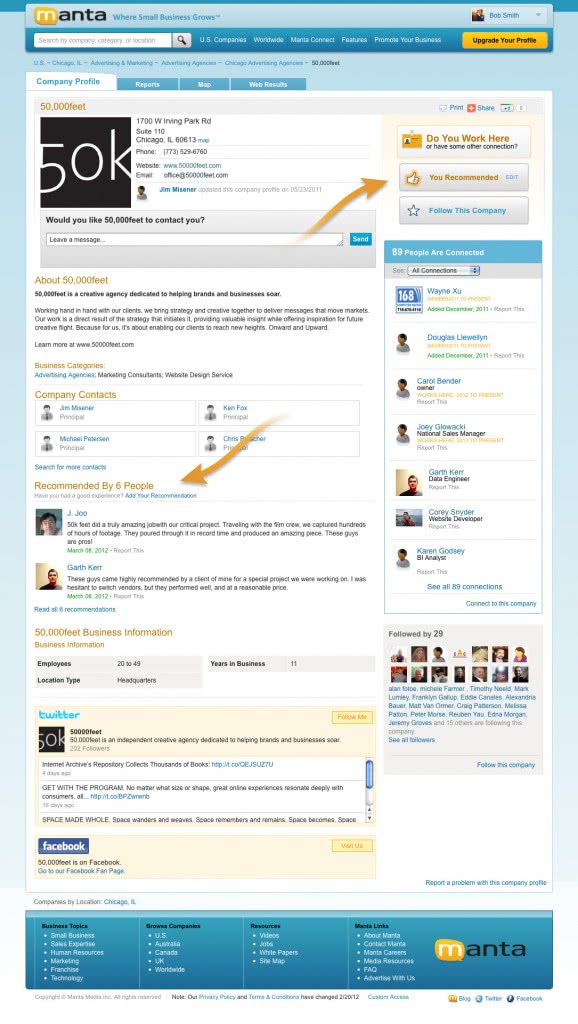How Manta's Online Community Helps SMBs Connect and Grow

Manta is an online network or community where small businesses connect with other businesses as well as potential customers. More than being a Yelp for small businesses, Manta is trying to positively impact small business revenues by providing a freemium ecosystem where content creation and consumption reinforce each other. We spoke with CEO Pam Springer about how Manta manages to impact these elusive small businesses in a meaningful way.
In a nutshell: what does Manta do?
We are trying to build a business network for small businesses. We want to be the end-to-end platform where small businesses can connect with each other and also their customers through the internet, mobile, and social. We have a huge adoption underway and think we’re in a unique spot. We already have 5% of US small businesses as members, and by the end of 2013 we aim to be closer to 10%. 3,000 small business owners currently claim their profiles every month. They are looking primarily to Manta to be found so that they can gain new customers. 80% of those 3,000 small businesses do not have a LinkedIn profile. They see it as a white collar network. 50% will have a Facebook fan page, but most of them aren’t managing it. So we believe there is a huge opportunity here: connecting and helping promote those elusive small businesses that previously were really hard to capture at scale.
Where did you get the idea for Manta?
Manta is a pivot. We had a predecessor: ECNext, which was launched many years ago. The value prop then was to build private-label eCommerce sites for big publishers. We offered to build sites for them that looked like their site, and then we’d take their content, SEO and SEM it, and then claim a revenue share. I joined in March ’03, when we only had 6 months of cash left. We managed to hit some important milestones, which extended the deadline by another 6 months. By then, I was the CEO and we switched gears a little. We started working with Dun & Bradstreet to distribute the 12 million company credit reports they had. We put our site on our own platform and took their 12 million company credit reports and sent them back a check every month.
In ’05 we went live as Manta, with a very thin value prop of just selling company credit reports online. The next step was to purchase company profiles and to give that info away for free in order to drive traffic to the site and monetize it through highly contextual ads. In January ’06, we went live with 20 million profiles. As soon as we did that, our phone started ringing off the hook. Small business owners started calling us to tell us they loved the free promotion, but that some of the data was wrong. So we asked them to fix it, and that’s when the a-ha moment came for us. We thought: we could have the best data in the world and build relationships with these companies at virtually no cost.
At first, we weren’t sure if these small businesses would even talk to each other on Manta, but lo and behold, they did – and actively so. They shared notes and operating tips and ask questions etc. Manta now serves as a marketplace but also a referral network.
In the early days, how did those small businesses learn about Manta? How did they know to call you and claim their profile?
Through vanity searches in Google, or maybe they were researching other companies and stumbled upon Manta. We were offering free promotion, so companies were very motivated to make sure the information we had on them was accurate and robust.
Our core audience has always consisted of three different people: the small business owner, the regular business people who are looking for fresh, updated content; and lastly, the consumer, who uses Manta to find answers about these companies. As each group grew, content creation started happening as well as content consumption. They were reinforcing each other. Profiles were being claimed. Keywords got richer, which the search engines loved, so then traffic grew, which further increased the need for companies to claim their profiles. And that effect is still happening.
Is there a cost associated with joining Manta?
We have a freemium model. Basic profiles are free, but if you choose to have something supercharged, there’s a $29, $39, or $49 monthly subscription that you can elect to sign up for.
What do you feel you do differently than other online business communities or networks?
We’re different in several ways if you think about a Yelp or a YellowPages or an Angie’s List. Their channels consist of all people. That model doesn’t scale, and none of those guys are very profitable, if at all. Their acquisition of the SMB audience is very inefficient compared to Manta’s. We’re the next generation – those guys just didn’t get it right. Because their cost model is so high, the value of what they sell to the SMB has to be pretty high too. So they charge much higher fees than we do, and if you think about SMBs and the financial constraints they are under, that type of model just doesn’t make sense. 51% of US companies have $1,000 or less to spend on marketing. They can’t afford to go downstream, but we can afford to go upstream. Manta is not so much about reviews like Yelp. We’re about building a community of small businesses that are following and referring each other, which drives actual commerce.
Is there a recommendations engine involved?
We are working on a recommendations engine. So if you’re looking at a painting company, we may recommend a tile company to go along with it. We have related companies now, but soon we’ll be pushing who you should follow or look at based on who you are – not on someone else’s reviews.
You mentioned you have 26M companies on the site, of which 1.5M have claimed their profile. How many of those have paid for the premium upgrade?
The subscription launched last year and we already have close to 50,000 subscribers.
How is Manta set up in terms of office location, team size, etc.?
We have about 130 people now, up from 80 people at the beginning of 2012. We’re headquartered in Columbus, OH, and have major sales offices in New York City, Charlotte, and Denver – because we’re trying to reach not just small business owners, but also Fortune 500 advertisers who are looking to get in front of our audience at scale. Our sales team calls on Amex, FedEx, Dell etc. who want to run sophisticated campaigns to reach the small businesses on our site.
What do personally find most exciting about Manta?
We’re building a one-of-a-kind, never-been-done thing. We’re capturing the small business owner at scale and impacting them in a meaningful way. 80% of US companies have 9 employees or less, so you’re really impacting a business owner and their families, and that’s a pretty cool thing to rally around. We didn’t set out to do that, but here we are by paying attention and building to our strengths.
Besides Manta, which companies do you find the most interesting?
I have a lot of respect for Google, and the quantitative nature of their decision-making processes. I’m also interested in how Marissa Mayer is turning Yahoo around. You have to give a huge salute to LinkedIn in terms of consistently performing. There are also up-and-comers like Square which are disrupting old, traditional markets.









